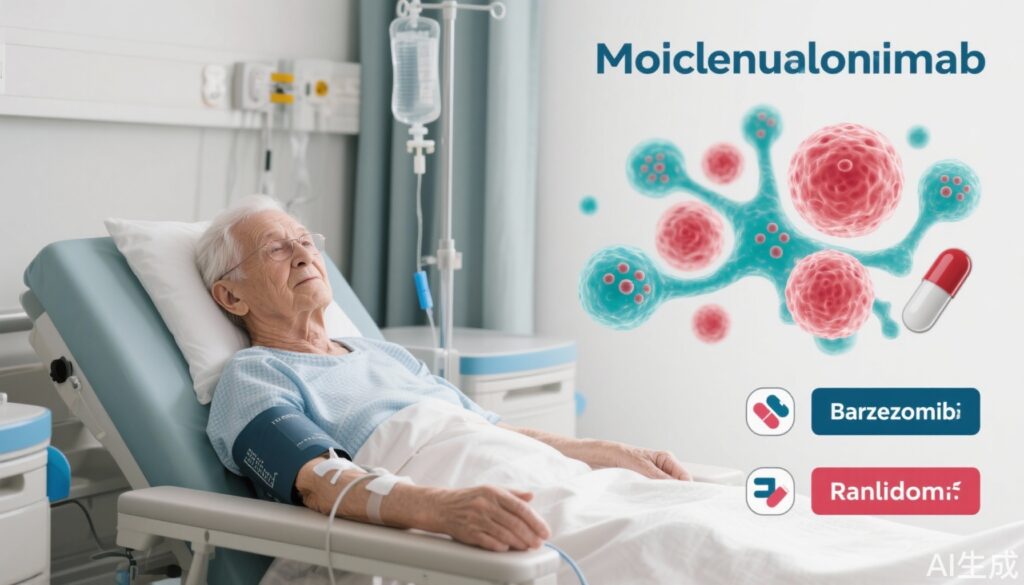Highlight
– The REST Phase 2 trial evaluated a quadruplet regimen using isatuximab, weekly bortezomib, lenalidomide, and limited dexamethasone in transplant-ineligible newly diagnosed multiple myeloma (NDMM).
– Achieved a median treatment duration of 22 months with a 37% rate of measurable residual disease (MRD)-negative complete response, indicating deep and durable remissions.
– The regimen demonstrated a manageable safety profile with limited dexamethasone use, reducing corticosteroid-related complications such as infection.
Study Background and Disease Burden
Multiple myeloma (MM) primarily affects elderly patients who are frequently ineligible for autologous hematopoietic stem cell transplantation (HSCT) due to comorbidities or frailty. While incorporation of anti-CD38 monoclonal antibodies into frontline therapy has improved outcomes in transplant-eligible MM patients, evidence for optimal regimens in transplant-ineligible populations remains limited. Traditionally, standard of care includes proteasome inhibitors like bortezomib and immunomodulatory drugs such as lenalidomide, often combined with corticosteroids like dexamethasone. However, prolonged corticosteroid use is associated with increased infection risk, particularly in older adults with compromised immunity. Hence, new strategies balancing efficacy and safety with limited corticosteroids are essential for this vulnerable patient group.
Study Design
The REST trial is a prospective, multicenter, single-arm Phase 2 study enrolling adults with newly diagnosed MM who are transplant-ineligible due to advanced age or comorbidities, including those with Eastern Cooperative Oncology Group (ECOG) performance status up to 3 if related to myeloma. Patients had measurable disease per International Myeloma Working Group (IMWG) criteria. Treatment consisted of 28-day cycles with isatuximab administered intravenously at 10 mg/kg weekly during cycle 1 (days 1, 8, 15, and 22), then biweekly for cycles 2 through 18. Bortezomib was given subcutaneously weekly at 1.3 mg/m2 on days 1, 8, and 15 during cycles 1 to 8, while lenalidomide was administered orally at 25 mg on days 1 to 21 continuously until disease progression. Dexamethasone was limited to 20 mg orally on days 1, 8, 15, and 22, but only for the first two cycles, aiming to minimize corticosteroid-related toxicity.
The primary endpoint was achievement of MRD-negative complete response (CR), evaluated by next-generation flow cytometry with a sensitivity of detection to 1 × 10-5 malignant plasma cells, assessed at or after cycle 18. MRD testing was performed for all patients who achieved at least CR before cycle 19 and those with very good partial response at cycle 19. All patients who initiated treatment were included in the efficacy and safety analyses. The trial was registered at ClinicalTrials.gov (NCT04939844).
Key Findings
Between June 30, 2021, and January 19, 2023, REST enrolled 51 patients (27 females, 24 males) with a median age of 77 years (interquartile range 73.5–80 years), a population representative of the transplant-ineligible elderly MM cohort. Of these, 39 patients completed 18 cycles of treatment according to protocol; two had discontinued treatment prior but continued protocol follow-up. Median treatment exposure was 22 months.
At a median follow-up of 27 months, 19 patients (37%; 95% CI 25.3–51.0) achieved MRD-negative complete response, reflecting deep eradication of malignant plasma cells. Disease progression or death occurred in 18 patients (35%), and overall mortality was 16% (8 patients). These results underscore the durability and potent activity of the quadruplet regimen in this high-risk population.
Safety evaluation showed frequent grade 3-4 adverse events, consistent with myeloma therapy and patient population frailty. The most common were neutropenia in 55% and infections in 41% of patients, emphasizing the immunosuppressive challenges in elderly patients despite limited steroid use. Thrombocytopenia was noted in 22%, with 48 serious adverse events grade 3 or higher reported among 53% of patients. Treatment discontinuation prior to cycle 19 was 27%, mainly due to disease progression (16%) and adverse events (8%). Two treatment-related deaths were documented—one from pneumonia and another from sepsis—highlighting continuing risks in this setting.
Expert Commentary
The REST trial provides important clinical insights into the feasibility of incorporating the anti-CD38 antibody isatuximab into a bortezomib and lenalidomide backbone with a markedly reduced corticosteroid exposure in elderly transplant-ineligible patients. Most standard quadruplet regimens include prolonged dexamethasone, which can exacerbate immunosuppression, glucose intolerance, and other steroid-related morbidities, particularly problematic in this patient demographic.
Achieving a 37% MRD-negative CR rate is notable given the advanced age and frailty of the cohort, aligning with recent advances highlighting MRD negativity as a surrogate marker for improved progression-free and overall survival in MM. The inclusion of weekly bortezomib, allowing dose intensity while reducing peripheral neuropathy risk compared with twice-weekly dosing, further optimizes tolerability.
Limitations of the trial include its single-arm design, which warrants confirmation in randomized comparisons. Furthermore, longer-term follow-up is necessary to evaluate sustained survival benefits and late toxicity. Nonetheless, the safety profile, including manageable neutropenia and infection rates despite advanced age, supports the regimen’s real-world applicability. This steroid-reduction strategy aligns well with emerging trends toward personalizing therapy intensity to patient fitness and tolerance.
Conclusion
The REST Phase 2 study substantiates that frontline treatment with isatuximab, weekly bortezomib, lenalidomide, and curtailed dexamethasone is an effective and tolerable option for elderly patients with newly diagnosed multiple myeloma who are ineligible for autologous HSCT. The regimen achieves meaningful MRD-negative remissions while potentially reducing the complications associated with prolonged corticosteroid therapy.
These findings may influence future standard-of-care protocols and support broader incorporation of anti-CD38 antibodies in this vulnerable population. Ongoing and future studies should focus on confirming these results and optimizing treatment sequencing to maximize efficacy while minimizing toxicity in the elderly.
References
1. Askeland FB, Haukås E, Slørdahl TS, et al. Isatuximab, bortezomib, lenalidomide, and limited dexamethasone in patients with transplant-ineligible multiple myeloma (REST): a multicentre, single-arm, phase 2 trial. Lancet Haematol. 2025;12(2):e120-e127. doi:10.1016/S2352-3026(24)00347-8
2. Kumar SK, Callander N, Hillengass J, et al. Multiple myeloma, version 3.2021, NCCN clinical practice guidelines in oncology. J Natl Compr Canc Netw. 2020;18(10):1685-1717. doi:10.6004/jnccn.2020.0046
3. Landgren O, Rajkumar SV. New strategies in multiple myeloma: precision medicine at the front line. Clin Cancer Res. 2020;26(6):1231-1235. doi:10.1158/1078-0432.CCR-19-3220
4. Moreau P, et al. Daratumumab, lenalidomide, bortezomib, and dexamethasone for newly diagnosed multiple myeloma. N Engl J Med. 2019;380(22):2104-2115. doi:10.1056/NEJMoa1817240



